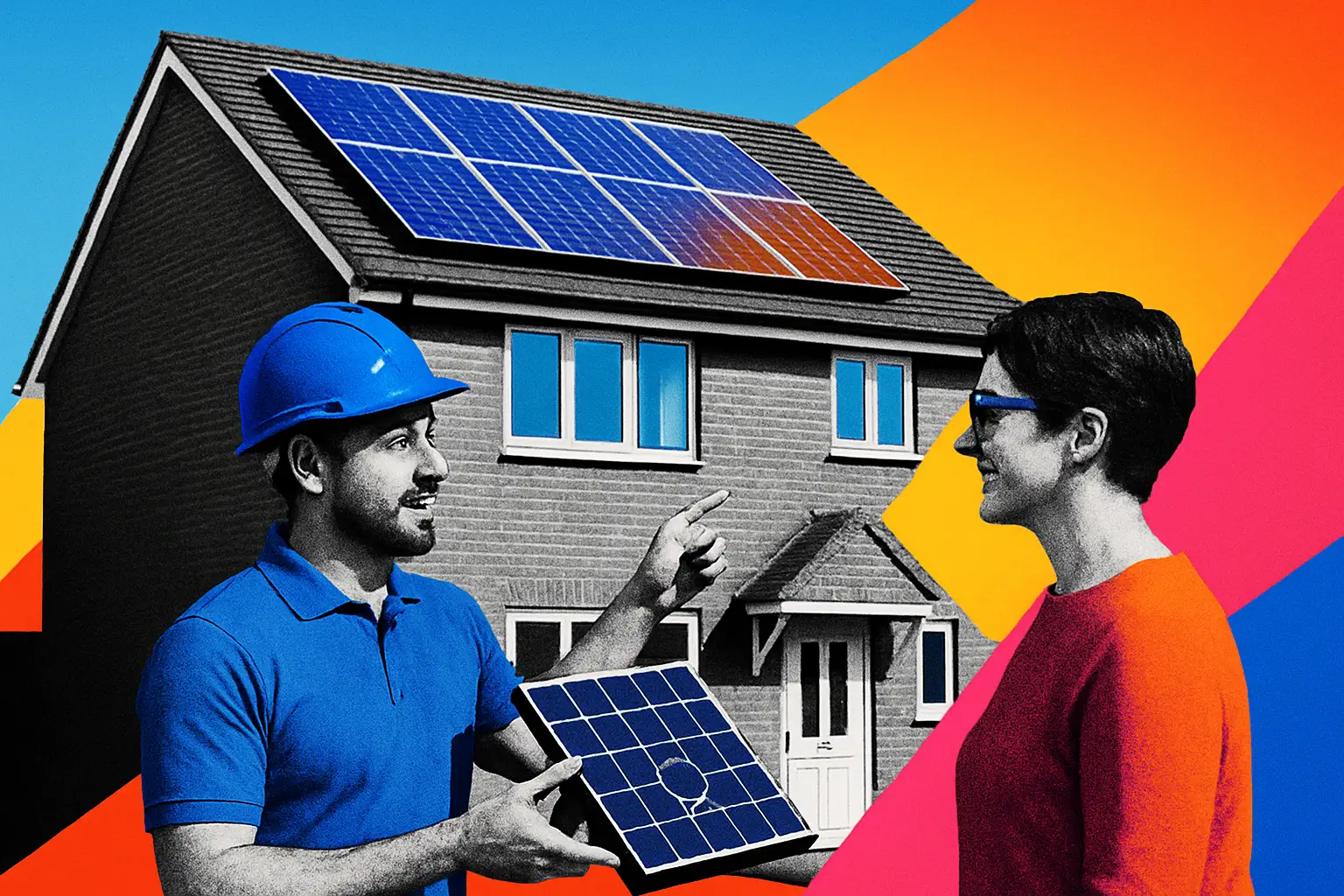Solar panels Home services jargon buster: key terms explained
A clear, UK-focused guide to solar jargon, from kW and kWh to inverters, batteries, MCS and SEG, so you can choose the right system and maximise savings.
Cut through the solar speak in minutes
Solar quotes can be packed with acronyms and assumptions. This guide explains the essentials in plain English, tailored for GB homes. Understand the kit, the numbers and the schemes before you sign.
Understanding APR is about pounds and pence - solar is no different. Clarity turns estimates into confident decisions.
Is this guide for you?
If you are a UK homeowner comparing solar quotes, planning a roof upgrade, or wondering whether batteries or SEG payments make sense, this is for you. We keep it practical, grounded in UK standards, and focused on real outcomes like bills, savings and payback.
The building blocks - what the terms actually mean
- Photovoltaic cell: A semiconductor device that turns sunlight into direct current electricity. Cells are the tiny squares you see within panels.
- Module, panel and array: Cells make a module. One or more modules wired together form a panel. Multiple panels connected become an array sized to roof space and energy needs.
- DC vs AC: Panels generate DC. Homes and the GB grid run on AC. You need an inverter to convert DC to usable AC.
- Inverter: The system brain. It converts DC to AC and affects total output. Higher efficiency can mean higher usable energy and better savings.
- Battery storage: Stores surplus daytime solar for evening use, boosting self-consumption and cutting imports from the grid.
- kW, kWh, kWp:
- kW - power at a moment in time.
- kWh - energy used or generated over time, as seen on bills.
- kWp - maximum panel output under ideal test conditions, used to size systems in the UK.
- Solar PV vs solar thermal: PV makes electricity. Solar thermal heats water. They solve different problems and can complement each other.
- Angle and pitch: In the UK, pitches of 30 to 45 degrees and a south-facing aspect typically produce higher yields. Mounts can improve less optimal roofs.
- MCS certification: UK quality mark for products and installers. Often required for SEG payments and lender or insurer acceptance.
Choosing kit and configurations
Panel types compared
| Panel type | Typical efficiency | Cost profile | Look | Best for |
|---|---|---|---|---|
| Monocrystalline | Higher | Higher | Sleeker black | Limited roof space, premium finish |
| Polycrystalline | Slightly lower | Lower | Blue-speckled | Larger roofs, tighter budgets |
Inverter options
- String inverter - Cost effective for simple roofs. Performance can dip if one panel is shaded.
- Microinverters - Panel-level conversion. Better where shading or complex roofs exist, with improved monitoring.
- Power optimisers - Hybrid approach with a central inverter and per-panel optimisation.
Battery choices
| Battery type | Typical capacity range | Cycle life | Notes |
|---|---|---|---|
| Lithium-ion | 5 to 15 kWh | High | Most common for UK homes |
| LFP variants | 5 to 15 kWh | Very high | Stable chemistry, slightly larger footprint |
Tips:
- Size batteries to evening use, not total generation.
- Check usable capacity, not just headline kWh.
- Ensure warranty covers throughput and years.
PV vs thermal - different jobs
| Solution | Primary purpose | Typical benefit | Works with |
|---|---|---|---|
| Solar PV | Electricity | Bill cuts, SEG income | Heat pumps, EVs, batteries |
| Solar thermal | Hot water | Gas or electricity savings | Cylinders, combi-compatible kits exist |
Pounds, performance and sensible risks
- Costs: Typical domestic PV systems in GB vary by size and equipment preference. Premium inverters or batteries raise upfront cost.
- Savings: Higher self-consumption and efficient inverters lift returns. Batteries can improve bill reductions by shifting solar to evenings.
- SEG income: You are paid for exported surplus. Rates vary by supplier, tariff and whether you are on fixed or variable export.
- Returns: Payback depends on usage profile, energy prices, roof orientation and system size in kWp.
- Risks and mitigations:
- Shading lowers yield - consider optimisers or microinverters.
- Overestimating export - match system size to demand and storage.
- Warranty gaps - check parts and labour, years, and performance guarantees.
Standout point: Battery value is highest when it meaningfully displaces peak-time imports.
Who can qualify and what to check
- Property: Most pitched roofs qualify. Flats or shaded sites may need alternative mounting or smaller arrays.
- Standards: For SEG, you typically need MCS-certified products plus MCS installer sign-off and a smart meter capable of export readings.
- Electrical compliance: Inverters must meet UK grid standards. DNO notifications or approvals may be required depending on system size.
- Metering: A smart meter simplifies export payments and monitoring.
- Roof condition: Installers may request remedial works before fitting to protect warranties and performance.
- Planning: Most domestic systems fall under permitted development. Conservation areas, listed buildings or street-facing arrays may require consent.
From quote to switch-on - the simple path
- Roof survey and shade assessment
- Proposal with kWp, inverter and battery options
- Confirm MCS-certified products and installer
- DNO notification or approval if required
- Installation and electrical sign-off
- MCS certificate issued and system commissioning
- Smart meter export setup and SEG tariff registration
Weighing it up - benefits and trade-offs
Pros:
- Cuts electricity bills and exposure to price spikes
- SEG income for surplus exported to the grid
- Increases resilience when paired with storage
- Low maintenance with long product warranties
Cons and considerations:
- Upfront cost, especially with batteries
- Output varies by season and roof orientation
- Shading can limit performance without panel-level optimisation
- Roof works may be needed before installation
Read the small print before you commit
- Verify MCS numbers for both products and installer.
- Review inverter and battery warranties for years and throughput.
- Check the SEG tariff rate, payment frequency and metering requirements.
- Ensure quotes clearly separate kW, kWh and kWp and include expected annual kWh generation.
- Confirm scaffolding, remedials and DNO processes are included in price.
If solar is not a fit today
- Energy efficiency first - insulation, LED lighting, smart heating controls.
- Time-of-use tariffs - shift appliances to cheaper periods.
- Heat pump readiness - plan electrical upgrades that also support future PV.
- Community and rooftop schemes - collective purchasing can improve pricing.
FAQs
Q: What size system do I need? A: Many UK homes install 2 to 6 kWp depending on roof space and usage. Match size to daytime demand and consider a battery if evenings are your heavy-use period.
Q: Do I need a battery for SEG? A: No. SEG pays for net exports whether or not you have storage. A battery helps you use more of your own energy before exporting.
Q: How long do panels last? A: Many panels carry 20 to 25 year performance warranties. Inverters may have shorter warranties, often 5 to 12 years, with extensions available.
Q: Will a north-facing roof work? A: Yields are lower. East or west can still be viable. Mounts may improve angles and designers can model expected kWh to guide decisions.
Q: What maintenance is needed? A: Minimal. Occasional cleaning where soiling is an issue, and inverter checks through monitoring apps. Annual visual inspections are advisable.
Q: Can I power my home during an outage? A: Standard grid-tied systems shut down for safety. Some hybrid inverters and batteries offer backup circuits if specified.
Ready to move forward?
- Gather your last 12 months of kWh usage and peak times.
- Request MCS-backed quotes with clear kWp, kWh and inverter specs.
- Compare SEG rates and battery options by usable capacity and warranty.
Next step: book a no-obligation survey to size your array to your roof and routine.
Important information
This guide is general information for GB households and is not financial advice. Always confirm product specifications, warranties, MCS status and SEG eligibility with your installer and energy supplier before proceeding.
Get smarter with your money
Join thousands of people in the UK who are taking control of their financial future

FAQs
Common questions about managing your personal finances
Begin by tracking every expense for one month. Use an app or spreadsheet. No judgment. Just observe your spending patterns.
Cancel unused subscriptions. Cook at home. Compare utility providers. Small changes add up quickly.
Aim for 20% of your income. Start smaller if needed. Consistency matters more than the amount.
Choose reputable apps with strong security. Read reviews. Check privacy policies. Protect your financial data.
Pay bills on time. Keep credit card balances low. Check your credit report annually. Be patient.
Still have questions?
Our team is ready to help you navigate your financial journey
More financial insights
Explore our latest articles on personal finance and money management




